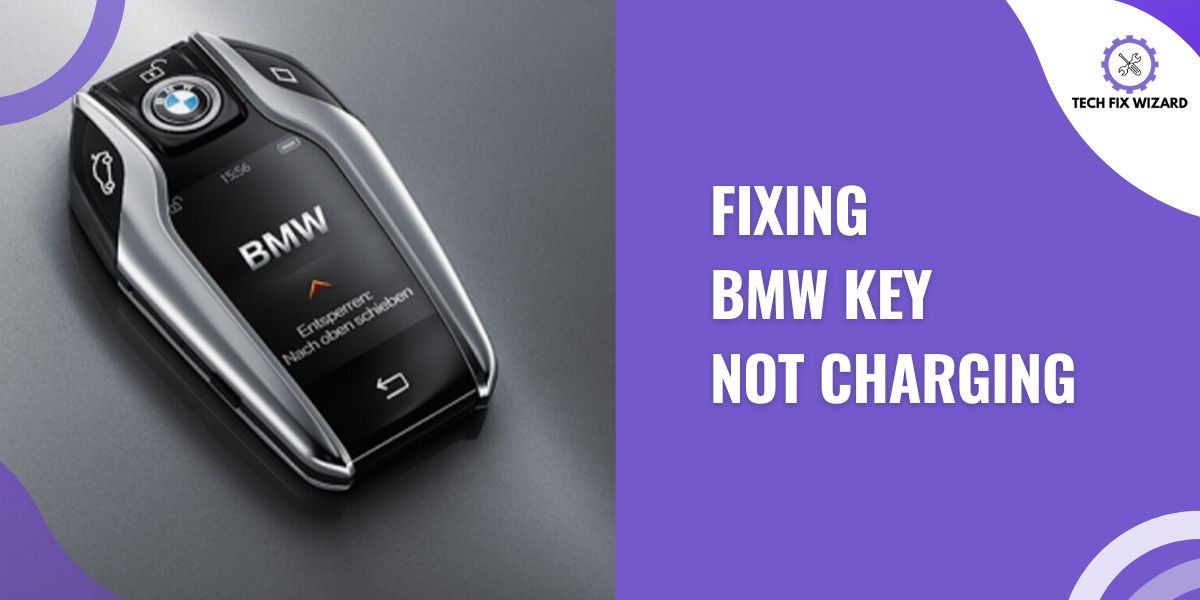The BMW key plays a crucial role in accessing and operating your BMW vehicle, providing convenience and security.
However, encountering the BMW key not charging issue can be a frustrating experience. But worry not!
In this article, we will provide practical steps to identify and resolve the BMW key not charging issue.
So, let’s dive into it!
Contents
- 1 Exploring Charging Methods for Your BMW Keys
- 2 Troubleshooting BMW Key Not Charging – 6 Steps to Try
- 3 1. Checking the Charging Cable
- 4 2. Inspecting the Charging Port
- 5 3. Verify the Power Source
- 6 4. Resetting the Key
- 7 5. Replacing the Battery
- 8 6. Seeking Professional Assistance
- 9 Preventing Future Charging Issues
- 10 FAQs
- 11 1. Is it possible to overcharge a BMW key fob?
- 12 2. How can I tell if my BMW key is not charging?
- 13 3. Can a dead battery cause the BMW key not to charge?
- 14 4. What should I do if my BMW key is not charging?
- 15 5. Can a faulty charging port be the reason for the key not charging?
- 16 6. How often should I charge my BMW key?
- 17 7. Can using a generic charger affect the charging of my BMW key?
- 18 8. Is it possible to replace the battery in my BMW key?
- 19 9. What are the signs of a failing BMW key battery?
- 20 10. When should I consider seeking professional help for a BMW key not charging issue?
- 21 11. Can a low battery level cause other issues with the key fob besides charging problems?
- 22 12. Will using a non-BMW charging cable damage the key fob or affect its charging performance?
- 23 13. Are there any common user errors that can cause charging issues with a BMW key fob?
- 24 Official References & Resources
Exploring Charging Methods for Your BMW Keys
Before delving into troubleshooting steps, it’s important to understand that BMW keys can be charged through various means and methods, depending on the specific model and features.
The following table provides information on different charging methods for your BMW:
| # | Charging Method | Description |
|---|---|---|
| 1. | Charging Port | Connect the key to a charging cable, then plug the cable into a power source like a USB port or dock. |
| 2. | Wireless Charging | Place the key on a wireless charging pad or dock for wireless charging. |
| 3. | Inductive Charging | Place the key in a charging tray or slot that uses electromagnetic induction for charging. |
| 4. | Vehicle Charging | Charge the key while it is inside the vehicle in a designated charging compartment. |
It’s important to verify the charging method that is easily applicable to your BMW key.
By checking the owner’s manual or consulting with a BMW dealership or authorized service center, you can determine the appropriate charging method for your key.
Once you know the correct charging method, you can proceed to troubleshoot any charging issues by following the steps specific to that method.
Troubleshooting BMW Key Not Charging – 6 Steps to Try
There are several troubleshooting steps you can take to resolve the BMW key not charging problem.
By following those steps, you can identify and address common issues that may be preventing your key from charging properly.
Let’s get started!

1. Checking the Charging Cable
Before diving into other troubleshooting steps, it is essential to verify the condition of the charging cable used for the key fob.
A faulty or damaged charging cable can prevent proper charging and lead to a BMW key not charging issue.
Follow these steps to check the charging cable:
| Step | Action |
|---|---|
| 1. | Inspect the charging cable for any visible damage or wear and tear. |
| 2. | Replace the cable if you notice frayed wires or cracks in the casing. |
| 3. | Ensure that the charging cable is securely plugged into both the key fob and power source. |
| 4. | Try unplugging and re-plugging the cable firmly to establish a secure connection. |
2. Inspecting the Charging Port
After checking the charging cable of your BMW key fob, the next step in troubleshooting the charging issue is to inspect the charging port.
The charging port is located on the key fob and is responsible for establishing a connection with the charging cable.
| Step | Description |
|---|---|
| 1. Visual Inspection | Visually inspect the charging port for any signs of physical damage, corrosion, or rust. |
| 2. Use a Flashlight | If necessary, use a flashlight to get a better view of the inside of the charging port. |
| 3. Clean Out Debris | If you notice any debris or dirt inside the charging port, gently clean it out using a soft-bristled brush. |
3. Verify the Power Source
After inspecting the charging cable and charging port it’s important to verify the power source as well.
Sometimes, the problem may not lie with the key itself, but rather with the power source being used for charging.
You can follow the steps below to verify the power source:
- Connect another device, such as a smartphone or tablet, to the power source and check if it charges properly. This will help determine if the power source is functioning correctly.
- If the alternate device charges without any issues, it indicates that the power source is likely functioning correctly.
- However, if the alternate device doesn’t charge or you suspect the power source is inadequate, proceed to the next step.
- Try using a different USB port, charging dock, or wall charger to see if that resolves the issue. This will help eliminate any potential problems with the specific power source you were initially using.
- Inspect the charging adapter for any visible damage or wear. If you notice any issues, consider trying a different charging adapter to rule out any problems with the adapter itself.
- Ensure a secure and stable connection between the charging cable and the power source. Check for any loose connections or faulty wiring that may be affecting the charging process.
- If you are using a USB port, make sure it is powered and enabled for charging. Some USB ports may not provide sufficient power for charging devices.
- Avoid using low-quality or incompatible charging accessories, as they may not provide adequate power to charge the key. Opt for reliable and certified charging accessories that are suitable for your BMW key.
4. Resetting the Key
If you’re still experiencing issues with your BMW key not charging, the next step to consider is resetting the key.
This simple process can often resolve charging problems. To reset the key, follow these steps:
- Insert the key fob into the ignition and turn it to the “On” position.
- Immediately turn the key back to the “Off” position and remove it from the ignition.
- While holding down the unlock button on the key fob, press and release the lock button three times.
- Release the unlock button.
5. Replacing the Battery
Replacing the battery in your BMW key fob should be considered a final resort if all other troubleshooting steps have failed to resolve the charging issue.
While the key fob battery is rechargeable in most cases, there may be instances where the battery has degraded over time and requires replacement.
To replace the battery, follow these steps:
- Determine the correct battery type: Consult the owner’s manual or research online to identify the specific battery type required for your BMW key fob.
- Open the key fob: Use a small flathead screwdriver or a knife to carefully pry open the back cover of the key fob. Be gentle to avoid damaging the key fob or the battery compartment.
- Remove the old battery: Take note of the battery’s orientation and carefully remove it from the battery compartment.
- Insert the new battery: Insert the new battery into the battery compartment with the correct orientation, ensuring that it fits securely.
- Close the key fob: Glue the back cover of the key fob in place.
- Test the key fob: Place the key fob in the charging slot or station to verify if the new battery has resolved the charging issue.
Remember, If you are unsure about replacing the battery yourself or if the charging issue persists even after replacing the battery, it is recommended to seek professional assistance or visit a BMW service center for further diagnosis and repair.
6. Seeking Professional Assistance
If you have tried the previous troubleshooting steps and your BMW key still isn’t charging, it may be time to seek professional assistance.
Seeking professional assistance ensures that your BMW key is diagnosed and repaired by qualified technicians who are familiar with the intricacies of the key’s charging system.
They have access to the necessary tools and resources to effectively address the issue and restore your key’s charging functionality.
Preventing Future Charging Issues
To prevent future charging issues with your BMW key, there are several proactive steps you can take:
- Keep it clean: Regularly clean your key fob to prevent dirt, dust, and debris from accumulating on its surface, including the charging contacts.
- Protect from extreme temperatures: Avoid exposing your key fob to extreme heat or cold for prolonged periods. High temperatures or freezing temperatures can degrade the battery while freezing conditions can affect its performance.
- Regular charging routine: Make it a habit to charge your key fob regularly, especially when the battery level is low.
- Use the correct charger: Always use the charger specifically designed for your BMW key fob.
- Replace the battery when necessary: Over time, the rechargeable battery in your key fob may degrade and become less efficient. If you notice a significant decrease in battery life or charging issues despite proper maintenance, consider replacing the battery with a new one to restore optimal performance.
By following these preventive measures, you can minimize the chances of encountering charging issues with your BMW key fob.
FAQs
1. Is it possible to overcharge a BMW key fob?
Yes, it is possible to overcharge a BMW key fob. This can lead to battery damage and potentially render the key unusable.
Be sure to only charge the key for the recommended amount of time.
2. How can I tell if my BMW key is not charging?
You may notice that the key’s buttons are unresponsive, the key fob’s LED does not light up when pressed, or the key fob fails to unlock or start the vehicle.
3. Can a dead battery cause the BMW key not to charge?
Yes, a dead battery is one of the common causes of a BMW key not charging. If the battery is depleted, it won’t be able to hold a charge and will need to be replaced.
4. What should I do if my BMW key is not charging?
Start by checking the battery and ensuring it is properly inserted. If the battery is fine, inspect the charging port and clean it if necessary.
If the issue persists, you may need to replace the battery or seek professional help.
5. Can a faulty charging port be the reason for the key not charging?
Yes, a damaged or dirty charging port can prevent the key from charging properly. It’s important to inspect the charging port and clean any debris or consider replacing it if needed.
6. How often should I charge my BMW key?
It is recommended to charge your BMW key regularly, especially if it has a rechargeable battery.
Charging it once every few weeks or as needed should be sufficient to keep it functioning optimally.
7. Can using a generic charger affect the charging of my BMW key?
Yes, using a generic or incompatible charger can potentially damage the key’s battery or cause charging issues.
It is best to use the original charger or a compatible one recommended by the manufacturer.
8. Is it possible to replace the battery in my BMW key?
Yes, most BMW key fobs have replaceable batteries. Refer to the user manual or consult a BMW dealership to determine the correct battery type and replacement procedure.
9. What are the signs of a failing BMW key battery?
Signs of a failing BMW key battery may include reduced range, intermittent key fob functionality, or the need to press the buttons multiple times for them to work.
10. When should I consider seeking professional help for a BMW key not charging issue?
If you have tried troubleshooting steps like replacing the battery and cleaning the charging port, but the key still doesn’t charge, it may be time to consult a professional BMW technician who can diagnose and repair the issue.
11. Can a low battery level cause other issues with the key fob besides charging problems?
If your BMW key fob has a low battery level, it can cause issues beyond charging problems. It may not unlock the car or start the engine.
Consider replacing the battery to avoid further problems.
12. Will using a non-BMW charging cable damage the key fob or affect its charging performance?
Using a non-BMW charging cable won’t damage your key fob or affect its charging performance.
However, it’s important to ensure that the cable you use is compatible with your device and doesn’t cause any overheating issues.
13. Are there any common user errors that can cause charging issues with a BMW key fob?
You may be experiencing charging issues with your BMW key fob due to common user errors such as not placing it on the wireless charger correctly or a dead battery. Ensure proper placement and try replacing the battery first.
Official References & Resources
Our research for providing accurate information about BMW involved a thorough analysis of official resources, including the official BMW website owner’s manuals, technical specifications, and relevant support forums.
Our research and data gathering involved thorough analysis of the official websites, including:

John Paul is a tech enthusiast dedicated to troubleshooting. He is passionate about fixing glitches, simplifying complexities, and empowering others in the digital realm.

